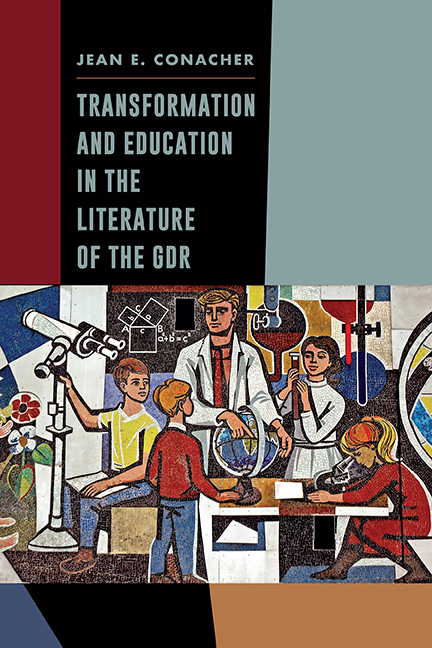Book contents
- Frontmatter
- Dedication
- Contents
- List of Illustrations
- Acknowledgments
- List of Abbreviations
- Introduction: The Postwar Desire for Renewal
- 1 Shaping the Cultural and Educational Landscape in the Soviet Occupation Zone (SBZ)
- 2 Interweaving GDR Education and Cultural Policy toward a National Literature
- 3 Critiquing the Norm in Steinmann' Die größere Liebe, Wolf' Der geteilte Himmel, and Kant' Die Aula
- 4 “Ich bin. Wer?“: Subjectivity and Transformation in Wolf' Nachdenken über Christa T. and Reimann' Franziska Linkerhand
- 5 “Wem geben wir Einsen … ?” Meritocracies and Reward in de Bruyn' Die Preisverleihung and Plenzdorf' Die neuen Leiden des jungen W.
- 6 “Mir geht es gut”: Challenging Stagnation in Hein' Der fremde Freund and H�ntsch' Wir sind keine Kinder mehr
- Conclusion
- Appendix A Text-Internal Functions of Narrative Triangle (Left Side)
- Appendix B Text-External Functions of Narrative Triangle (Right Side)
- Notes
- Bibliography
- Index
3 - Critiquing the Norm in Steinmann' Die größere Liebe, Wolf' Der geteilte Himmel, and Kant' Die Aula
Published online by Cambridge University Press: 25 March 2020
- Frontmatter
- Dedication
- Contents
- List of Illustrations
- Acknowledgments
- List of Abbreviations
- Introduction: The Postwar Desire for Renewal
- 1 Shaping the Cultural and Educational Landscape in the Soviet Occupation Zone (SBZ)
- 2 Interweaving GDR Education and Cultural Policy toward a National Literature
- 3 Critiquing the Norm in Steinmann' Die größere Liebe, Wolf' Der geteilte Himmel, and Kant' Die Aula
- 4 “Ich bin. Wer?“: Subjectivity and Transformation in Wolf' Nachdenken über Christa T. and Reimann' Franziska Linkerhand
- 5 “Wem geben wir Einsen … ?” Meritocracies and Reward in de Bruyn' Die Preisverleihung and Plenzdorf' Die neuen Leiden des jungen W.
- 6 “Mir geht es gut”: Challenging Stagnation in Hein' Der fremde Freund and H�ntsch' Wir sind keine Kinder mehr
- Conclusion
- Appendix A Text-Internal Functions of Narrative Triangle (Left Side)
- Appendix B Text-External Functions of Narrative Triangle (Right Side)
- Notes
- Bibliography
- Index
Summary
THROUGH THE 1950S, the GDR itself began to grow up, making the transition from occupied zone to full-fledged state and carving a position for itself both in opposition to the Federal Republic and within the broader socialist family. The SED cemented its role as the country’s leading political force, increasingly subsuming cultural and educational policy under a framework designed to meet the economic needs of socialist development, although this proved a challenging task. Increasing difficulties in meeting the exponential targets of the five-year plans through the 1950s activated the seven-year “Plan des Friedens und des Sieges des Sozialismus” in October 1959. Under the superficially democratic slogan “Arbeite mit, plane mit, regiere mit,” this aligned the country's planning cycle more closely with the Soviet Union’s, joining a concerted international effort to compete economically with the capitalist West. The GDR as the “Schaufenster des Ostens” undertook to match and then overtake the Federal Republic's per capita consumption of everyday goods. Culture was to contribute to the “geistige Formung des neuen sozialistischen Menschen” within a framework reminiscent of Makarenko in its emphasis on the individual's journey within the socialist collective toward a meaningful life as a dynamic “sich allseitig entwickelnde Persönlichkeit.”
Political events quickly overtook economic and cultural plans: the building of the Berlin Wall in August 1961 constituted a caesura in East-West relations within German borders and beyond, while signaling tacit recognition that the GDR's grand narrative of representing “das bessere Deutschland” could not compete with the power of those voting with their feet and leaving the country. Sealed borders brought a sense of closure to individual decision-making to stay or go and reduced practically, if not politically, the need to compete directly with the Federal Republic. From January 1963, the New Economic System (NÖS), quietly replacing the Seven-Year Plan, sought to introduce greater flexibility into the economy, as Stephen Frowen indicates, by combining central planning with limited free-market-style measures and incentives. The closing of the country's western borders thus resulted in a hitherto unknown period of stability for GDR society, as the country's sense of political legitimacy was strengthened by a more keenly defined economic, cultural, and national identity.
- Type
- Chapter
- Information
- Transformation and Education in the Literature of the GDR , pp. 79 - 110Publisher: Boydell & BrewerPrint publication year: 2020

